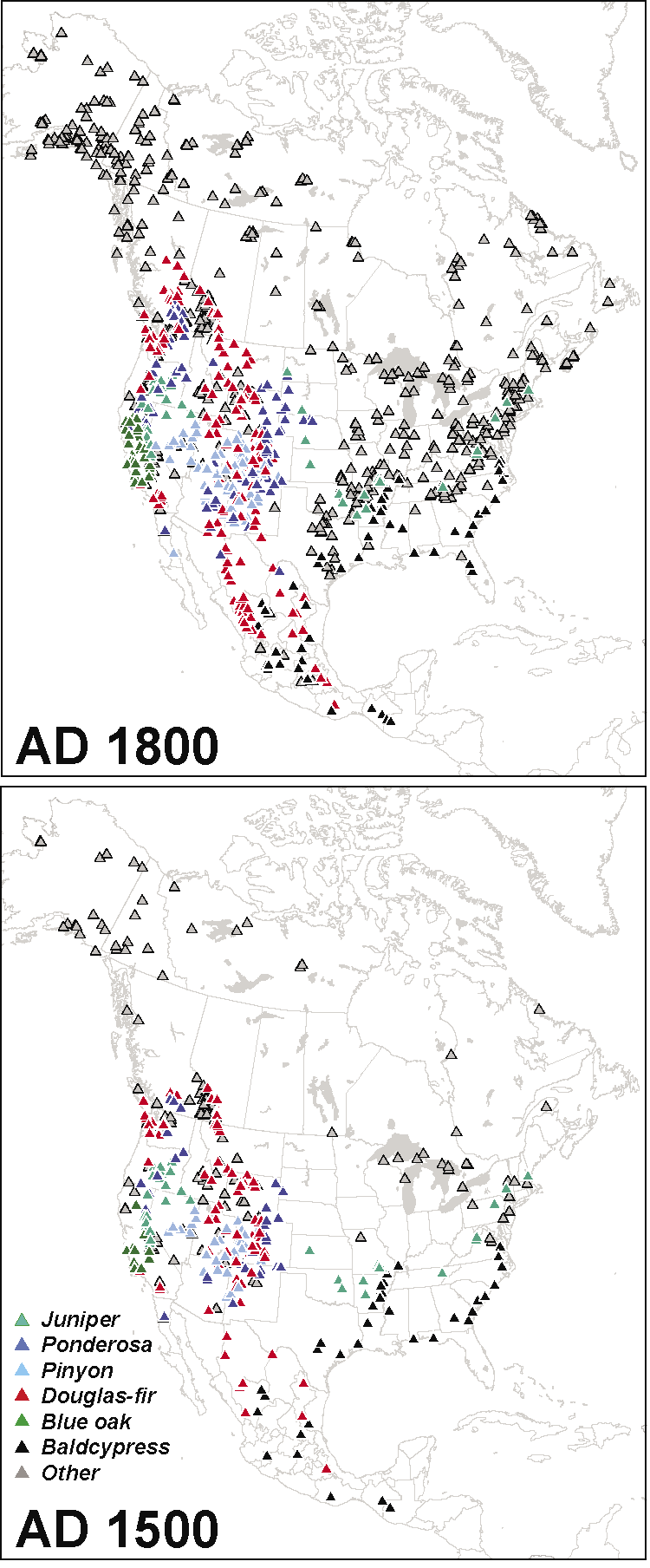- Home
- Publications
- PAGES Magazine
- North American Dendroclimatic Data: Compilation, Characterization, and Spatiotemporal Analysis
North American Dendroclimatic Data: Compilation, Characterization, and Spatiotemporal Analysis
Valerie Trouet, D. Stahle and H. Diaz
PAGES news
20(1)
52
2012
Valerie Trouet1, D. Stahle2 and H. Diaz3
1Laboratory for Tree-Ring Research, University of Arizona, Tucson, USA; trouet ltrr.arizona.edu
ltrr.arizona.edu
2Department of Geosciences, University of Arkansas, Fayetteville, USA
3Cooperative Institute for Research in Environmental Sciences, University of Colorado, Boulder, USA
NAM2k Workshop, Tucson, USA, 26‐28 October 2011
 |
|
Figure 1: Species-specific tree-ring chronologies available for the North American continent that extend back to AD 1800 and AD 1500. |
During the first meeting of the PAGES North American 2k Working Group (NAM2k) in Flagstaff, USA, in May 2011, a task group was assigned to collaborate on the assimilation of available data sources and exploration of spatiotemporal analysis tools. Considering the numerical dominance of tree‐ring data within the climate proxy data pool for North America, this task group focuses in first instance on compiling and analyzing tree‐ring data, with the goal of producing a high-resolution reconstruction of key climate variables for North America (including Canada, USA, and Mexico). The necessary steps towards achieving this goal were discussed by 12 paleoclimatologists from the USA and Canada in a workshop held at the University of Arizona in Tucson. The workshop was supported by the University’s Institute of the Environment and by PAGES.
The participants first discussed available tree-ring data and their characteristics, including time-series length, seasonality, climate parameter calibration, and geographic representation (Fig. 1). The North American Drought Atlas (NADA, Cook et al. 2004) was generally accepted as a spatially explicit, high‐resolution drought reconstruction for North America that can likely not be improved upon without extensive new data collection. The working group will therefore aim to complement the NADA with a continental‐scale temperature reconstruction equivalent.
Two general approaches to the development of such a gridded temperature reconstruction were suggested: (1) compilation of all available tree‐ring data, regardless of the strength of their temperature‐sensitivity and extraction of the best possible temperature signal out of this extended data set or (2) a priori selection of best qualified tree-ring data and reconstruction development based on this limited data-set. The workshop participants decided to adopt the second approach and defined a set of selection criteria including a minimum time‐span covered by the tree‐ring series (AD 1650-1990) and strength (r>0.316), sign (positive), and seasonality (summer) of the temperature signal in the tree-ring series. Tree‐ring chronologies from the International Tree‐Ring Database (ITRDB) will be screened according to these criteria and complemented by chronologies from individual researchers, which have not yet been contributed to the ITRDB. The raw ring-width data contributing to the selected chronologies will be detrended using a signal-free approach before implementation in the reconstruction algorithm.
The task group aims to first apply a nested empirical orthogonal functions (EOF) based methodology. In a first step, only the tree-ring data covering the time-period AD 1200-1990 will be included. The next phase will include all previously selected tree-ring data. In addition to this EOF-based approach for spatial reconstruction, a Bayesian Hierarchical Model (BHM) will be used to extract climate information from the tree-ring time-series. Both methodologies will initially be run on annual time-scales, but also decadal-scale reconstructions will be developed that allow for inclusion of other, decadal-resolution proxies, including pollen data. For this purpose, the NAM2K working group will collaborate closely with the Arctic working group and a joint workshop will be organized.
reference
